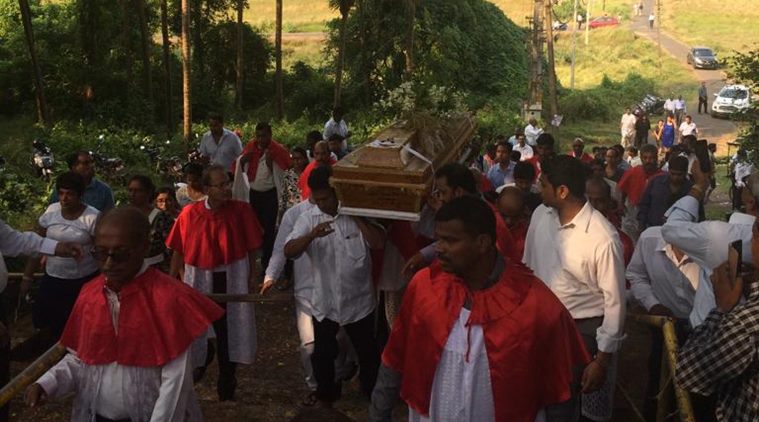 The coffin arrives in St Estevam, Goa. (Express photo by Smita Nair)
The coffin arrives in St Estevam, Goa. (Express photo by Smita Nair)
THREE YEARS after his death, with questions still swirling over how it happened, the body of Bismarque Dias, a former priest and activist, was finally brought back to his village in Goa’s St Estevam for burial. On Tuesday, an entire village stood silent as the coffin was carried across the paddy fields and inside the St Stephen’s Church on the hillock for final mass. “It’s a relief,” Nestor Rangel, a St Estevam resident and family friend, said.
“In many ways, there is a sense that the family did not get justice. The village, too. The official version is that it was a case of suicide, while the family suspects murder. He was a hindrance to many commercial projects that were coming in the vicinity and we feel his death had a story. The burial is important as he finally returns to his village, to his soil. The morgue is not where a man like him should rest,” Rangel said.
On November 6, 2015, 52-year-old Dias’s body was found floating in the Mandovi tributary about 20 km away, with the Goa Police initially recording it as an “unnatural death” and later attributing it to “foul play”. For months thereafter, activists, family and friends, too, alleged “foul play”, pointing to a video that Dias shot days before his death where he alleged that he was threatened by a lobby of builders and local politicians.
In 2017, after the family refused to take his body from the Goa Medical College and Hospital (GMCH) morgue, the death was registered as murder on the directions of the Panjim bench of the Bombay High Court.
According to police records, Dias had last gone for a swim near the Babal sluice gate near St Estevam with two boys. In their statement, the boys said that he went for a swim alone in the night. In April this year, the Crime Branch, which investigated the matter, told the High Court that all evidence “ruled out foul play”.
On Tuesday, as the coffin reached the church’s courtyard, it was covered with wishes and prayers, with goodbyes scrawled across the wooden casket. Inside the church, the benches were filled with mourners, and the walls had posters of a smiling Dias with a guitar on his shoulder.
For the village, the activist’s last words were represented by his song “Arey bala”, where he appealed to everyone to return to the fields. As The Indian Express reported on September 3 this year, the residents of St Estevam returned to farming after three decades to ensure that the land does not get usurped by developers.
Abhijeet Prabhudesai, a environment activist who attended the funeral, said the death “in many ways is the face of several small resistances in villages where big ticket projects are coming up at the cost of faulty resource allocation and the environment”.
“These resistances are often fought by people like Bismarque, and these struggles are important. The death is a reminder that Goa is losing a battle,” he said.
Residents of St Estevam recall that the first protest Dias, then a priest, staged was against the Church itself after he fought against the sale of its land to a private builder. He was soon disrobed, but went on to fight a number of land cases involving the village.
“These struggles are no longer our private struggles. These are battles that the entire state has to now fight. After his death, we have counted many projects that have come up in our area with political support. This is not land that we can give away so easily. There is a lot of effort that has gone into keeping Goa the way it is, and now we are going to take his fight forward,” Nevil Gomes, a businessman, said.